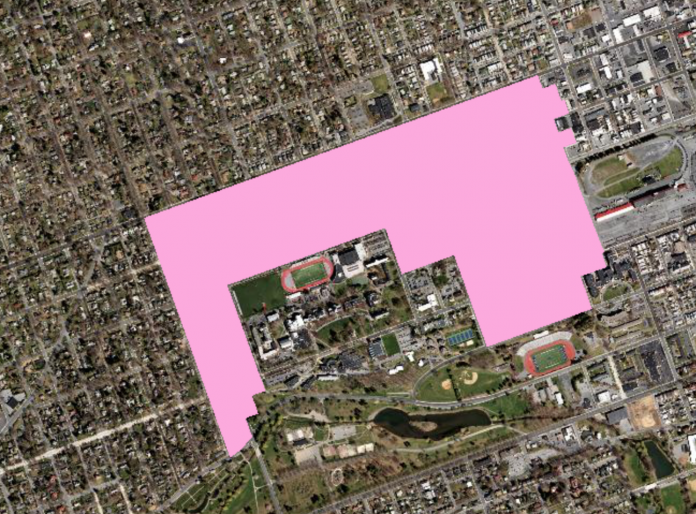On Feb. 21, the amount of future students who can live off-campus in newly acquired properties was restricted by the Allentown Planning Committee unanimous vote to expand the Allentown Student Residence Overlay District.
The Allentown Student Residence Overlay District is a zoning law, or an agreement between two parties as to how a geographical space is to be used. The overlay district was created in 1997 by Ordinance 59 to, as The Muhlenberg Weekly reported in a front-page article on the topic, “maintain the residential character of the neighborhood.” The agreement states that only two unrelated students can live under the same roof within the given area specified in this ordinance, called the Overlay District.
The Overlay District currently stretches in a blocky, lopsided U shape around campus. The Muhlenberg Office of Residential (ORS) services defines the area as the space bordered by Tilghman Street on the north, 27th Street on the west, 19th and Leh Streets on the east, and Parkway Boulevard on the south. The expansion approved by the committee would push the border one block north to Washington Street and one block to the west to 27th Street, according to the Morning Call.
Katie Shelley, Assistant Director of Residential Services, explained that the College will not be losing any beds to this ordinance. When the original ordinance passed, the two-student limit only applied to properties acquired by the College after ordinance 59 was enacted, meaning houses already owned by the College as student-only housing were exempt. As a result, there are select MILE houses that are “grandfathered” in and can house up to four students; most of these houses became group housing. This ordinance, according to ORS, also applies not only to College-owned properties, but also any rentals that house college students. Shelley believes the same will occur this time.
“We anticipate it being pretty similar,” said Shelley. “The dates may shift. But the immediate students who are in those houses, the immediate students who are scheduled to live there for next year will not be impacted.”
When originally proposed in 1997, the College labeled the ordinance as discriminatory towards students. An article in the September 4, 1997 issue of The Weekly shows Allentown residents concerned for the “deterioration of a single-family neighborhood.” This time around, the College has not taken such a strong stance, explained Allison Gulati, Dean of Students.
“We have maintained a fairly neutral stance because, number one, likey any property with students in them that will be impacted will be part of that grandfathering process. Number two, we believe that keeping students relatively close to campus is important to their success as college students. So if you look at that map, some of those places that are included in the expansion students wouldn’t choose to live there anyway,” she said.
A study conducted by the Indiana University School of Education showed that students of all races who lived on campus or within walking distance interacted with faculty on average at five percent more than students who lived further than walking distance from campus. Although Indiana did report that students on campus spent more time on extracurricular activities and socializing, it was not much more than their walking distance or further counter parts.
“All research related to student success in college states that when you live residentially, you are more likely to be successful academically,” said Gulati. “You are closer to health, academic, and social resources that you might need. You’re more likely to stay engaged in clubs and organizations on campus. And you’re less likely to skip class, be late to class, etc. For all those reasons, we want to keep students as close as possible.”
Additionally, Gulati pointed out, houses far off campus pose a safety hazard both to students and residents. Crossing Tilghman is dangerous when sober, added Gulati, not to mention after a night of partying. Most of these houses remain vacant over the summer, added Gulati, tempting burglaries and increasing crime rates. The additional rotation of students living there makes forming a cohesive neighborhood difficult for year-to-year residents.
As part of the Master Plan, Muhlenberg intends to build an apartment-style upperclassmen dorm with retail space on the ground floor, which will move more students on campus while also replacing the beds in The Courts.
Nearly twenty years after the ordinance passed, the Morning Call’s report on a town hall on the expansion revealed that homeowners were concerned with the resale values of their homes and the “wolf packs” of students “roaming from one party to another on weekends.”
Despite these limitations in this one area, everywhere else in the city up to four students are allowed to live in a house at a time reported the Morning Call. Only within the overlay district are students limited to living in pairs. As a result, there are several college-owned properties that have the room to house two students if needed, but are restricted due to zoning laws.
Chloe Gravereaux is the current Editor-in-Chief of the Muhlenberg Weekly, to which she has contributed since her freshman year. She dabbles in all forms of verbal and visual art, specializing in journalism and short fiction. Her unrivaled color coordination skills and investment in the dollar section of Target have earned her the nickname "Office Mom."






















